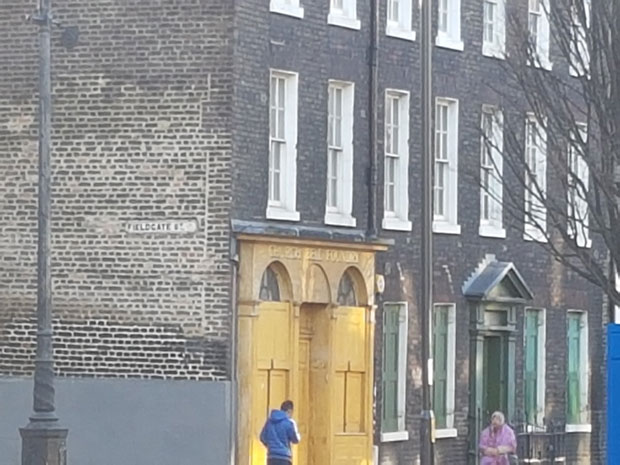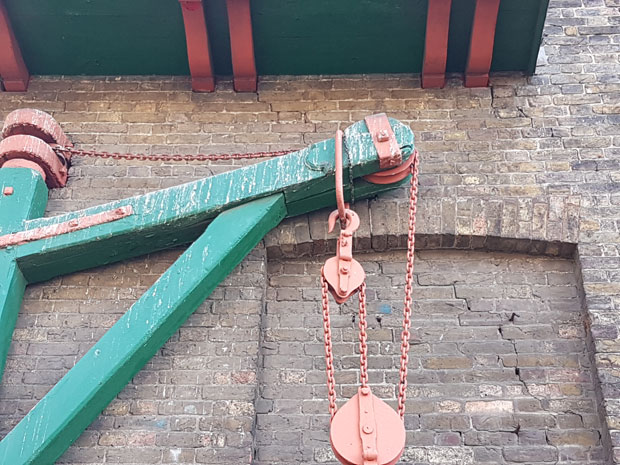One of the sadder bits of news in the last month is that the Whitechapel Bell Foundry, which has existed on a site just up the road from the Whitechapel Art Gallery for over 250 years and in Aldgate for much longer, is due either to move or to close down altogether in May this year.
The origins of the business go back to 1420 to a Master Founder called Robert Chamberlain, who made church bells in Aldgate. In 1583, Robert Mot took premises in Essex Court off the north side of Whitechapel High Street and, as well as making guns for Queen Elizabeth’s navy, supplied bells to churches in Kent and the City of London. The business moved to its current location on the south side of the High Street during the mid 1740s, when, in 1743, the Daily Advertiser advertised the availability of a lease on ‘The Old Artichoke Alehouse’ and four years later the Manor Court Rolls record ‘a new built messuage’ occupying the site.

Photo: Charles Saumarez Smith
The original building, still surviving, but not necessarily in its current form for much longer, is a remarkably well preserved piece of early industrial architecture, domestic in scale on the front where the offices and boardroom are, with workshops behind where there used to be a stables and coach-house. As Ian Nairn wrote in 1968, ‘All the parts are admirably proportioned in space, of an order which would excite admiration if an eminent name were attached to the drawings. More important, they are proportioned in life. This rhythm of living-place and work-place is fundamental’. According to the Guinness Book of Records, it is Britain’s oldest manufacturing company.
The problems the business faces are twofold. The first is that the supply of church bells as a business is not what it was, in spite of a recent boom in orders for table bells stimulated by Downton Abbey. The second is the huge change in property values in East London, as the city expands eastwards into Aldgate and the whole area has become more fashionable. London Metropolitan University has recently sold its John Cass building for a sum said to be in the region of £50 million and the value of the Whitechapel Bell Foundry must be an incentive to moving.

Photo: Charles Saumarez Smith
So what will happen to the buildings? There is a rumour that the site may already have been sold in order to achieve its full development value. But, if English Heritage has its wits about it, there will be very heavy restrictions on what can be done to the historic fabric of the buildings. Ideally, the buildings would be maintained in some form of active use, perhaps by one of the businesses who specialise in art fabrication, like Factum Arte. Otherwise, there is a danger that some of the historic fabric will be retained, but neutered in a new development of flats.
Charles Saumarez Smith has written a book about East London featuring the Whitechapel Bell Foundry, published by Thames & Hudson on 27 April 2017.

What will become of the Whitechapel Bell Foundry?
The Whitechapel Bell Foundry has existed for over 250 years on a site just up the road from the Whitechapel Art Gallery and in Aldgate for much longer. Photo: Charles Saumarez Smith
Share
One of the sadder bits of news in the last month is that the Whitechapel Bell Foundry, which has existed on a site just up the road from the Whitechapel Art Gallery for over 250 years and in Aldgate for much longer, is due either to move or to close down altogether in May this year.
The origins of the business go back to 1420 to a Master Founder called Robert Chamberlain, who made church bells in Aldgate. In 1583, Robert Mot took premises in Essex Court off the north side of Whitechapel High Street and, as well as making guns for Queen Elizabeth’s navy, supplied bells to churches in Kent and the City of London. The business moved to its current location on the south side of the High Street during the mid 1740s, when, in 1743, the Daily Advertiser advertised the availability of a lease on ‘The Old Artichoke Alehouse’ and four years later the Manor Court Rolls record ‘a new built messuage’ occupying the site.
Photo: Charles Saumarez Smith
The original building, still surviving, but not necessarily in its current form for much longer, is a remarkably well preserved piece of early industrial architecture, domestic in scale on the front where the offices and boardroom are, with workshops behind where there used to be a stables and coach-house. As Ian Nairn wrote in 1968, ‘All the parts are admirably proportioned in space, of an order which would excite admiration if an eminent name were attached to the drawings. More important, they are proportioned in life. This rhythm of living-place and work-place is fundamental’. According to the Guinness Book of Records, it is Britain’s oldest manufacturing company.
The problems the business faces are twofold. The first is that the supply of church bells as a business is not what it was, in spite of a recent boom in orders for table bells stimulated by Downton Abbey. The second is the huge change in property values in East London, as the city expands eastwards into Aldgate and the whole area has become more fashionable. London Metropolitan University has recently sold its John Cass building for a sum said to be in the region of £50 million and the value of the Whitechapel Bell Foundry must be an incentive to moving.
Photo: Charles Saumarez Smith
So what will happen to the buildings? There is a rumour that the site may already have been sold in order to achieve its full development value. But, if English Heritage has its wits about it, there will be very heavy restrictions on what can be done to the historic fabric of the buildings. Ideally, the buildings would be maintained in some form of active use, perhaps by one of the businesses who specialise in art fabrication, like Factum Arte. Otherwise, there is a danger that some of the historic fabric will be retained, but neutered in a new development of flats.
Charles Saumarez Smith has written a book about East London featuring the Whitechapel Bell Foundry, published by Thames & Hudson on 27 April 2017.
Share
Recommended for you
Paris museum group accused of ‘abuse of power’
Art News Daily : 4 January
Flemish portraits, science fiction, and an avant-garde centenary
Antwerp’s Old Master treasures are on tour, while the Barbican is staging a sprawling but ambitious science fiction exhibition
Balloon paintings, Baroque altarpieces and opera
Michael Andrews finally gets a showing at Gagosian, the National Gallery prepares for its spring blockbuster, and more